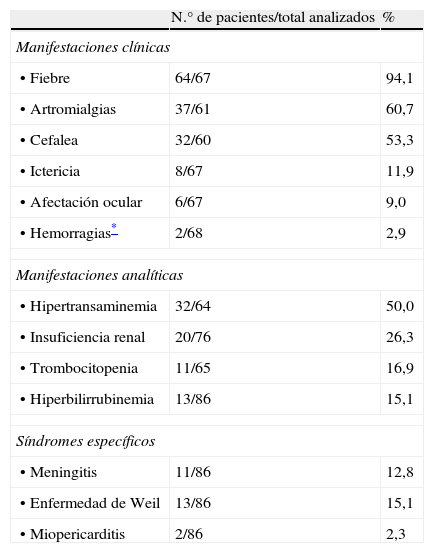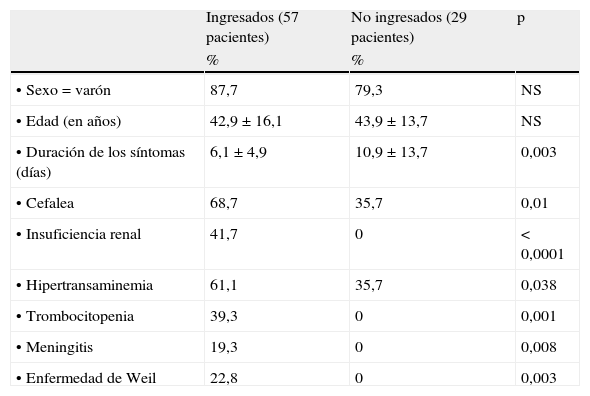La leptospirosis tiene una distribución mundial y predomina en regiones tropicales. Su incidencia puede estar infraestimada. Describimos las características de la leptospirosis en el suroeste de España.
Pacientes y métodosSerie de casos retrospectiva de 86 casos de leptospirosis diagnosticados entre abril de 1997 y abril de 2013. Se analizan datos epidemiológicos, clínicos, analíticos y pronósticos.
ResultadosLa edad media de los pacientes fue de 43,1 años (desviación estándar 13,8). El 84,9% fueron varones. La incidencia anual media fue de 1,99/100.000 habitantes. El 94% de los pacientes tenían actividades de riesgo: contacto con animales en el 82,5% y con aguas estancadas en el 31,7%. Las principales manifestaciones clínicas fueron la fiebre (94,1%), artromialgias (60,7%) y cefalea (53,3%). El 48% de los casos tuvieron hipertransaminemia, el 26,3% insuficiencia renal y el 16,9% trombocitopenia. Trece pacientes (15,1%) tuvieron enfermedad de Weil (EW) y 11 meningitis. Los pacientes con meningitis eran de menor edad (31,2±9,2 frente a 44,8±15,2, p=0,004) y los pacientes con EW de mayor edad (53,5±15,8 frente a 41,2±14,5, p=0,007). Cincuenta y siete pacientes requirieron hospitalización (66,3%) y 6 de ellos fallecieron (7,0%). Se asociaron a mortalidad la edad superior a los 60 años (odds ratio [OR] 45,0, intervalo de confianza al 95% [IC 95%] 4,7-436,6) y el diagnóstico de EW (OR 15,8, IC 95% 2,5-98,7).
ConclusionesLa leptospirosis tiene en nuestro entorno una incidencia no despreciable. Incide preferentemente en varones con actividades reconocidas como de riesgo, que presentan fiebre y artromialgias. Debe incluirse en el diagnóstico diferencial de la meningitis linfocitaria. La mortalidad se asocia a mayor edad.
Leptospirosis is a zoonosis of worldwide distribution and tropical predominance. Its incidence could be underestimated in template regions. We describe the manifestations of leptospirosis in an area of Southwestern Spain.
Patients and methodsEighty-six cases of leptospirosis (April 1997-April 2013) were retrospectively analyzed. The diagnosis was based in clinical and serological (Leptospira IgM ELISA) judgement. Epidemiological, clinical, laboratory, and prognostic dates were recorded.
ResultsThe mean age was 43.1±13.8 years (84.9% males). The mean annual incidence was 1.99/100.000. There were activities of risk in 94%: 82.5% contact with animals (57.4% pigs, 38.1% dogs, 31.7% cows, 22.2% sheeps), and 31.7% contact with pooled water. The most frequent symptoms were fever (94.1%), arthromyalgias (60.7%), and cephalalgia (53.3%). The main laboratory alterations were hypertransaminemia (48%), renal insufficiency (26.3%), and thrombocytopenia (16.9%). A lymphocytic meningitis was associated in 11 cases (12.5%) and a picture of Weil's disease was observed in 13 patients (15.1%). The patients with meningitis were younger (31.2±9.2 versus 44.8 ±15.2, p=0.004). The patients with Weil's disease were older (53.5±15.8 versus 41.2±14.5, p=0.007). Fifty seven patients were hospitalized (66.3%) and 6 patients died (7.0%). Factors independently associated with mortality were age >60 years (odds ratio [OR] 45.0, confidence interval 95% [CI95%] 4.7-434.6) and diagnosis of Weil's disease (OR 15.8, CI95% 2.5-98.7).
ConclusionsIn our experience, leptospirosis have a not despicable incidence and tends to show fever and arthromyalgias in men with risk activities. Leptospirosis should be included in the differential diagnosis of lymphocytic meningitis. Mortality is associated with older age.
Artículo
Diríjase desde aquí a la web de la >>>FESEMI<<< e inicie sesión mediante el formulario que se encuentra en la barra superior, pulsando sobre el candado.

Una vez autentificado, en la misma web de FESEMI, en el menú superior, elija la opción deseada.

>>>FESEMI<<<









